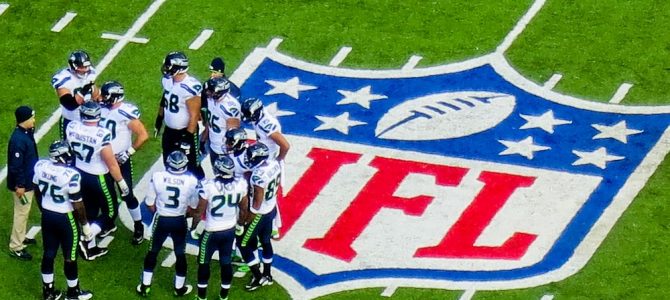
When a young player says he would gladly die on the field the same week more evidence of football’s C.T.E. epidemic was produced, fans must confront their part in a moral conundrum.
It was the worst kind of bad timing. When New York Jets rookie Jamal Adams said on Monday that a football field was a “perfect place to die,” he happened to be sitting next to the man desperately trying to convince Americans not to believe that competing in the National Football League is a death sentence. NFL Commissioner Roger Goodell has been in the crosshairs of critics who have lamented the league’s slowness to acknowledge its responsibility to former players who are ill or the need to ensure the safety of current players.
Goodell didn’t say anything in response to Adams, but few who heard his remarks could avoid thinking about the study published a week earlier by the Journal of the American Medical Association. A neuropathologist who had studied the brains of 111 deceased veterans of the National Football League discovered that a shocking 110 of them contained evidence of Chronic Traumatic Encephalopathy, or C.T.E.
Scientists and doctors believe that repeated blows to the head cause that degenerative disease, and this latest publication only adds weight to the concerns that growing numbers of parents have about letting their children play the sport.
Should We Enjoy A Sport That Ends In Death?
But rather than merely focus on Goodell and the league’s various legal entanglements as it has fended off lawsuits stemming from the plight of former players, perhaps its also time for football fans to ponder the morality of enjoying a sport that is part of a process that turns healthy young athletes into middle-aged corpses racked by dementia and various disabilities. Though that is the last thing those who eagerly looked forward to the opening of NFL training camps last week were thinking of, if football is as dangerous as these studies make it appear to be, then how can Americans who take the notion of moral responsibility seriously in other aspects of their lives simply ignore the human cost of their favorite entertainment?
Though the NFL’s television ratings have been battered by the distractions of modern American life, both college and professional football are obsessively watched by vast numbers of Americans. The NFL is a $13 billion business whose annual championship game has become nothing less than a secular holiday observed and celebrated even by many who don’t otherwise care about the sport.
But even as it maintains its place atop the sports and entertainment pyramid, football is facing a serious threat to its future. With each new C.T.E. study that is published, it is increasingly difficult for those who profit from the game and the millions who count the days until its return every fall to deny the dangers associated with playing the sport.
How long can an activity that may carry with it the likelihood of an awful life-shortening ailment continue to hold the imagination of the country? Those who believe football is too big and too popular to ever be cast aside should remember that only 80 years ago, boxing reigned alongside baseball as the country’s only true national sport. Even a half century ago, when Muhammad Ali was heavyweight champion, boxing was still immensely popular even if, unlike in previous generations, the percentage of youngsters who boxed was tiny. Today, it still exists and manages to hold a niche of the sports market, but it is a marginal endeavor derided for its brutality that increasingly few American care about.
We Can’t Ignore The Brain Trauma Football Causes
Will the same thing happen to football? Maybe. But if it manages to maintain its dominant status, it will be because Americans will have decided that the long-term effects on its players are not enough to cause them to change the channel.
Only four years ago, it was possible for a brilliant military historian like Max Boot to defend the sport on the pages of the Wall Street Journal by claiming that its critics exaggerated the risks of playing the game. Writing in 2013, Boot said studies had failed to prove that the average football player was doomed to dementia and early death. One study he cited said that an effort to discern evidence of cognitive impairment found nothing beyond evidence of “normal aging” in football players.
It’s true that among those who only play youth league, high school, or college football there is less likelihood of C.T.E. symptoms than among those few who make it to the NFL. But with more studies like the damning JAMA report coming out, the era of denial about the connection between football — especially at the professional level — and C.T.E. is over. The NFL’s long effort to pretend that the jury was still out about the cause of the disease has similarly come to an end, even as it skillfully sought to buy out its ill veterans with settlement offers. Instead of denial, the league now talks about its concern for the safety of its players.
This Doesn’t Mean Government Should Ban Football
As Jamal Adams complained while a stone-faced Goodell listened, many players and fans lament the advent of new rules that penalize hard hits on helpless players or the sort of deliberate blows to the head. Plays that were once considered examples of spirited play and glorified by NFL highlight films that featured the sound of colliding helmets and pads are now banned. The league is also researching helmets that will better protect the brains of its players. But no one, especially in the NFL, really thinks they can change the game to make it safe without losing the hits that made the sport popular.
In his Journal article, Boot cited the effort of President Theodore Roosevelt to help reform football more than a century ago, at a time when its uncontrolled brutality had prompted calls for it to be banned. As John Miller’s 2011 book “The Big Scrum” noted, TR’s efforts helped begin the transformation of a regional sport mired in 19th century mayhem into the modern game beloved by so many Americans. Boot quoted Roosevelt’s statement, in which he said those who would ban the game would turn out “mollycoddles instead of men” and predicted that his verdict would continue to stand no matter what medical studies said. Yet as much as I share Boot’s admiration for TR and his advocacy of the “vigorous life,” a decent respect for incontrovertible medical evidence is not proof of moral decline. All the bluster in the world can’t erase the spectacle of those 110 diseased brains of former players.
But, as is the case with boxing, that doesn’t mean government should ban football or seek to hinder those who wish to take part. Young athletic men have no sense of their own mortality. Nor is it likely that anyone in their 20s offered the chance for the riches available to NFL players would turn them down because something bad will happen to them in the future. It’s a rare football player who is able to look at the odds and — as 26-year-old Baltimore Ravens lineman John Urschel, who is also pursuing a math doctorate at M.I.T., did this year — just walk away from the game because the risks aren’t worth it.
Freedom Means The Ability To Make Choices, Good Or Not
Unlike banned blood sports involving animals — such as dog and cock fighting — in which the participants have no ability to refuse to participate, football is a voluntary activity. If players understand the risks— and only the willfully ignorant can still be unaware of the odds of long-term problems —then they should be allowed to take their chances. If, as has always been the case with professional boxing, NFL players are more likely to come from economically disadvantaged backgrounds, that choice is all the more understandable. Freedom means the ability to make choices rather than having the nanny state make them for us.
But what of the fans who adore the game? Will tens of millions of middle and upper class Americans continue to spend considerable portions of their lives glued to TV sets, watching the game even when they won’t let their own son’s brains be put at risk playing it? Will the loyal fans of college and pro football who consider themselves religious and bound by morality continue to cheer the same way knowing, as they now must, that what they are watching is, like ancient gladiator combat, a spectacle from which no one really walks away unscathed?
Perhaps they will. But anyone who thinks the financial future of the NFL isn’t in large measure tied to the damning reports about C.T.E. and the brains of dead football players is ignoring something that growing numbers of parents of young boys are taking to heart.









